
Station Name: HORNSEA BRIDGE[Source: Mark Dyson]
 LNER ex Great Northern Railway Class C12 4-4-2T No. 4544 stands at Hornsea Bridge with a Hornsea-bound train of at least two clerestory coaches. This locomotive had been GNR No. 1544 and was renumbered by the LNER to 4544 in March 1924. In October 1946 she became No. 7394 and went on to see service with British Railways No. 67394 until withdrawal in June 1958. Between the wars she spent many years resident at Hull Botanic Gardens shed. This view is looking south from Southgate and the motor car, which appears to be an Austin 12 and possibly a taxi, is on the corner of Marlborough Avenue. The somewhat ornate bridge carries details of its manufacturer which reads "1863 CLOSE AYRE & NICHOLSON PHœNIX FOUNDRY YORK". The omnibus is a Leyland Lion PLSC3 with Leyland 35 seat body, originally rear entrance but seen here apparently modified to front entrance. The registration letters "WF" were at this time allocated to the East Riding and the WF series began to be issued from August 1926. The dot between the letters and numbers was a matter for the issuing authority; some used a dot, some a dash, some just a blank space. Vehicle WF.1096 was new in 1928 and apparently to a firm in Willerby. In January 1933 it was one of many vehicles to be acquired by the East Yorkshire Motor Services, becoming this operator's fleet number 212. It was disposed of in October 1936 to Thomas Allsop Ltd of Sheffield. The fleetname is just about visible below the waistline on the second and third panels behind the entrance but it is totally unreadable. This means the date of this photograph can be pinned down to only the 1928 - 1936 period.LNER ex Great Northern Railway Class C12 4-4-2T No. 4544 stands at Hornsea Bridge with a Hornsea-bound train of at least two clerestory coaches. This locomotive had been GNR No. 1544 and was renumbered by the LNER to 4544 in March 1924. In October 1946 she became No. 7394 and went on to see service with British Railways No. 67394 until withdrawal in June 1958. Between the wars she spent many years resident at Hull Botanic Gardens shed. This view is looking south from Southgate and the motor car, which appears to be an Austin 12 and possibly a taxi, is on the corner of Marlborough Avenue. The somewhat ornate bridge carries details of its manufacturer which reads "1863 CLOSE AYRE & NICHOLSON PHœNIX FOUNDRY YORK". The omnibus is a Leyland Lion PLSC3 with Leyland 35 seat body, originally rear entrance but seen here apparently modified to front entrance. The registration letters "WF" were at this time allocated to the East Riding and the WF series began to be issued from August 1926. The dot between the letters and numbers was a matter for the issuing authority; some used a dot, some a dash, some just a blank space. Vehicle WF.1096 was new in 1928 and apparently to a firm in Willerby. In January 1933 it was one of many vehicles to be acquired by the East Yorkshire Motor Services, becoming this operator's fleet number 212. It was disposed of in October 1936 to Thomas Allsop Ltd of Sheffield. The fleetname is just about visible below the waistline on the second and third panels behind the entrance but it is totally unreadable. This means the date of this photograph can be pinned down to only the 1928 - 1936 periodLNER ex Great Northern Railway Class C12 4-4-2T No. 4544 stands at Hornsea Bridge with a Hornsea-bound train of at least two clerestory coaches. This locomotive had been GNR No. 1544 and was renumbered by the LNER to 4544 in March 1924. In October 1946 she became No. 7394 and went on to see service with British Railways No. 67394 until withdrawal in June 1958. Between the wars she spent many years resident at Hull Botanic Gardens shed. This view is looking south from Southgate and the motor car, which appears to be an Austin 12 and possibly a taxi, is on the corner of Marlborough Avenue. The somewhat ornate bridge carries details of its manufacturer which reads "1863 CLOSE AYRE & NICHOLSON PHœNIX FOUNDRY YORK". The omnibus is a Leyland Lion PLSC3 with Leyland 35 seat body, originally rear entrance but seen here apparently modified to front entrance. The registration letters "WF" were at this time allocated to the East Riding and the WF series began to be issued from August 1926. The dot between the letters and numbers was a matter for the issuing authority; some used a dot, some a dash, some just a blank space. Vehicle WF.1096 was new in 1928 and apparently to a firm in Willerby. In January 1933 it was one of many vehicles to be acquired by the East Yorkshire Motor Services, becoming this operator's fleet number 212. It was disposed of in October 1936 to Thomas Allsop Ltd of Sheffield. The fleetname is just about visible below the waistline on the second and third panels behind the entrance but it is totally unreadable. This means the date of this photograph can be pinned down to only the 1928 - 1936 period Photo received from Chris Partington 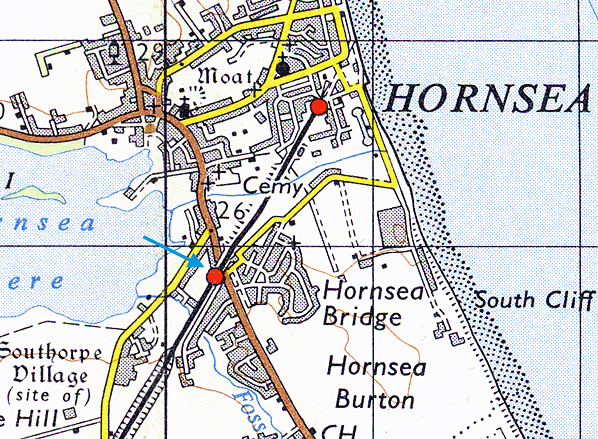 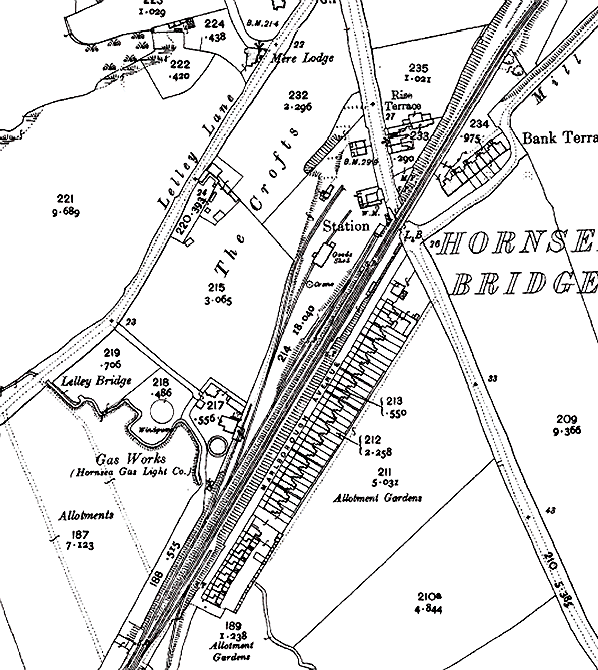
1910 1:2,500 OS map
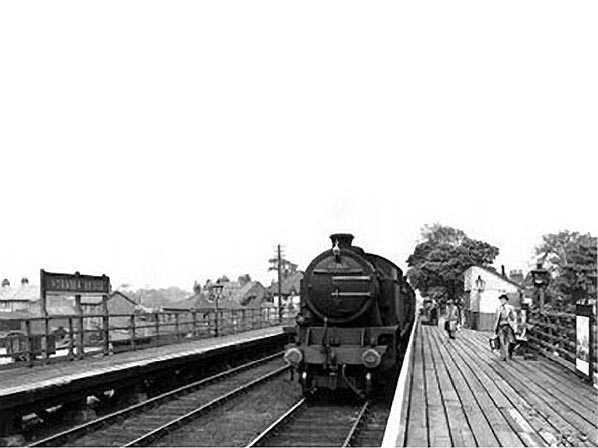 Hornsea Bridge station looking north from the up platform in the 1950s. Note the standard design NER waiting shelter 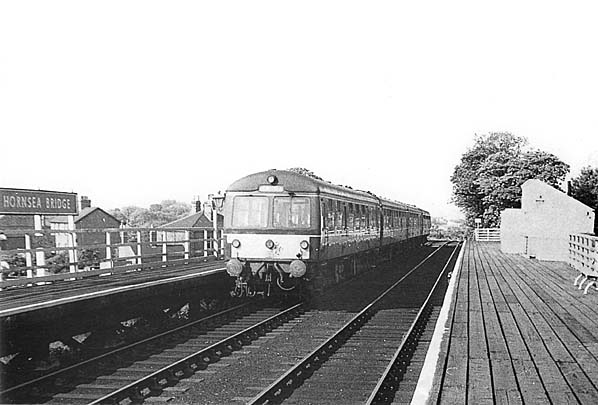 A Cravens DMU bound for Hornsea in the 1960's 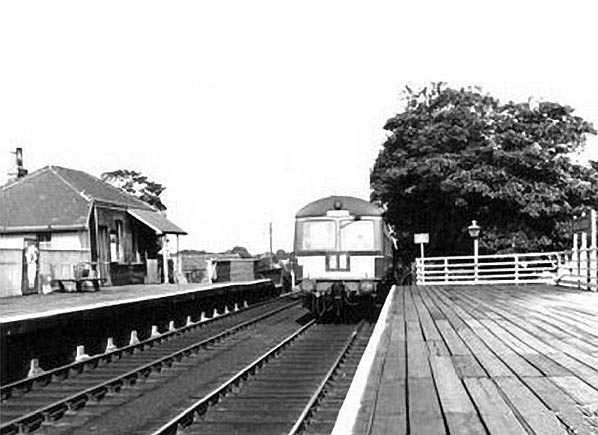 A southbound DMU arrives at Hornsea Bridge station in the 1960s. The main station building A southbound DMU arrives at Hornsea Bridge station in the 1960s. The main station buildingis seen on the left. bridge_old5.jpg)
Hornsea Bridge station looking north from the down platform in 1962. The goods yard, which is at ground level, is seen on the left.
Copyright photo from Stations UK 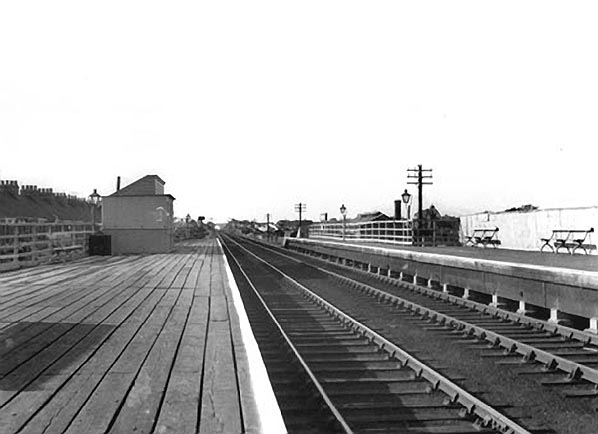 Hornsea Bridge station looking south from the up platform in the 1960's. bridge5.jpg)
The site of Hornsea Bridge station looking north in 1971. The concrete blocks seen on the left in front of the wall supported the timber platform.
Photo by John Mann bridge2.jpg)
Looking south across the B1242 towards the site of Hornsea Bridge station in July 2008. The station was on an embankment which is partially still there albeit narrower. The goods yard was at ground level and its site is now occupied by the industrial estate.
Photo by Mark Dyson bridge3.jpg) Looking south at the site of Hornsea Bridge station in July 2008. One side of the embankment has been removed to accommodate the industrial estate which is on the site of the goods yard.
Photo by Mark Dyson bridge1.jpg)
Looking north from the site of Hornsea Bridge station in July 2008
Photo by Mark Dyson 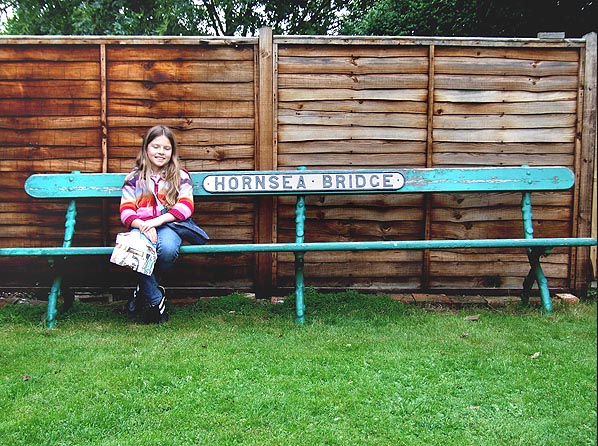
Hornsea Bridge station seat on display in the Hornsea Folk Museum.
Photo by Simon K from his Flickr photostream
 Home
Page Home
Page
|






